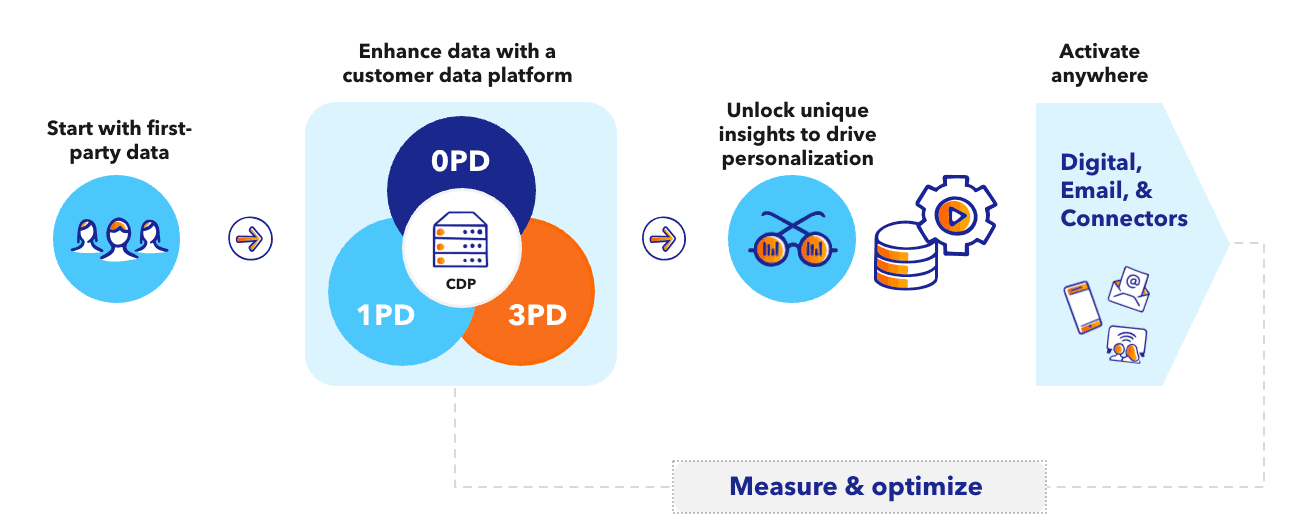


What is identity? In marketing, identity refers to a brand's understanding of a real person—information, behaviors and preferences—as they consume digital content and make transactions. Brands often use customer data platforms (CDPs) to organize and activate that data for marketing campaigns. Those tools can help glean insights based on information a brand already has, like past purchases, mobile app downloads or website visits. But even that doesn't tell the whole story.
Without a deeper understanding of their customers, brands may be activating on unreliable data. This is where identity resolution comes in: it helps brands see beyond a limited view of their customers and resolves any discrepancies—ensuring the pieces of data you have all come together to create an understanding of a real person in a digital context.
First-party data is the foundation of identity, but it can get complicated quickly. What a brand knows about their customers is limited, and people are complex. Consumers often have multiple emails, phone numbers and devices; they move, change their names, and evolve as their lives change.
When brands demonstrate that they don't know their customers, their customers notice. According to Epsilon research, "The push and pull of personalization," 76% of consumer respondents said they view brands negatively when they include inaccurate information about them in advertising messages. Compare that to the 91% of respondents who said they see at least one irrelevant ad every single day.
To deliver personalized experiences, brands need to have the best view of their customers. Not only that, they need a view that evolves with their customers.
There are ways to fill in those missing pieces.A CDP organizes a brand's first-party data, helping to unify everything they already have, but identity resolution actually cleanses, completes and expands the data by filling in gaps and missing data.
This gives brands insight into what a customer does outside of their owned channels, so they can go beyond just their first-party data to better understand what people are buying, what they're browsing, what they're watching and on what devices.
Now, most CDPs have some level of identity matching included in their technology, not true identity resolution. Identity matching is when a brand connects devices, emails or digital identifiers to existing customers. But it's easy conflated as being more than just one customer when it's really the same person.
For example: identity matching might not be able to connect a person's work email and their Gmail account. This leads to wasted budget. And it's not always up-to-date, meaning brands are missing opportunities to enhance audience targeting and personalization.
That is why many brands find they need to purchase an additional identity resolution layer that sits on top of their CDP—they need something that can bring in outside data to verify the accuracy of their own data and fill in the gaps.
Typically, the identity resolution step is purchased separately from another partner (outside the CDP but is a known integration with the technology), but it can be built into the CDP platform and comes included with the CDP purchase. The latter is certainly the better scenario, as then you don't have to onboard two different vendors to get the same outcome, and it ensures your identity resolution technology works seamlessly with your CDP technology.
CDPs that go beyond mere unification deliver the best view of the customer. They also give brands the power to align online and offline data and connect paid and owned channels to natively activate campaigns wherever their customers are.
A persistent, unified view of an individual means brands can speak to their customers about the right products on the right devices at the right time. It also illuminates the customers who have perhaps fallen off: people who are seasonal shoppers, people who have gone to a competitor, or people who are strong in-market candidates for a product a brand hadn't previously thought to market them.
When coupled with AI, brands can deliver these personalized experiences at-scale. This is a game-changer for marketers: it amplifies results, accelerates outcomes and helps drive real business impact.
It also drives more seamless customer journey orchestration. Deeper insights inform what customers will respond to. When brands know which offers to promote with the right creative and messaging on the channels and devices the customer prefers, they create a single narrative that flows as a seamless experience.

It's important for brands to have identity resolution capabilities built into their CDP, and they should seek a vendor who offers a secure, privacy-forward framework that makes marketers feel in control. The right CDP gives brands mastery over their data, channels and their job.
Epsilon Customer, a CDP solution, has identity and data built in, giving brands the best view of the customers to increase lifetime value. Our single-activation platform comes with a simplified user experience that leverages AI, meaning marketers can do their job quickly and accurately.